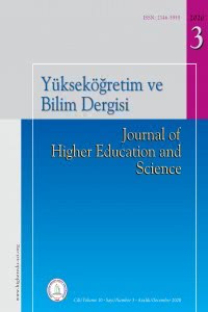Hemşirelik Öğrencilerinin Otonomi Düzeyleri
Otonomi, Otonomi düzeyi, Hemşirelik öğrencisi, Hemşirelik eğitimi
Autonomy Levels of Nursing Students
Autonomy, Autonomy levels, Nursing students, Nursing education,
___
- Adams, D., & Miller, B.K. (2001). Professionalism in nursing behaviors of nurse practitioners. Journal of Professional Nursing, 17(4), 203-210. https://doi.org/10.1053/jpnu.2001.25913.
- Arabacı, L.B., Taş, G., Kavaslar, İ., Dikmen, M., & Teke, C. (2017). Relationship between sociotropy autonomy personality traits, interpersonal sensitivity and facebook addiction in nursing students. Journal of Dependence, 18(3): 69-79.
- Atalay, E., Karadağ, A., & Göçmen, Z. (2005). Sociotropy-autonomy levels of –Gazi University School of Nursing students. IV. National Nursing Students Congress, Ordu, Turkey, 5– 6 May 2003; Congress Abstract Book: 30.
- Best, M.F., & Thurston, N.E. (2006). Canadian public health nurses' job satisfaction. Public Health Nursing, 23(3), 250–255. https://doi.org/10.1111/j.1525-1446.2006.230307.x.
- Büyükbayram, A., Baysan Arabacı, L., Taş, G., & Varol, D. (2016). The Relationship between the Emotional Intelligence and Sociotropy-Autonomy Personality Traits of Nursing Students and Their Resilience. İzmir Kâtip Çelebi University Faculty of Health Sciences Journal, 1(3), 29-37.
- Didişen, N. A., Gerçeker, G. Ö., Bolışık, Z. B., Zümrüt Başbakkal, D., & Gürkan, A. (2015). The relation between pediatric nurses’ sociotropy-autonomy personality features and their depression levels. Journal of Behçet Uz Childeren’s Hospital, 5(1), 14-21. https://doi.org/10.5222/buchd.2015.014.
- Iliopoulou, K.K., & While, A.E. (2010). Professional autonomy and job satisfaction: Survey of critical care nurses in mainland Greece. Journal of Advanced Nursing, 66(11), 2520–2531. https://doi.org/10.1111/j.1365-2648.2010.05424.x.
- Karagozoglu, S. (2008). Level of autonomy of Turkish students in the final year of university baccalaureate degree in health related fields. Nursing Outlook, 56 (2), 70–77. https://doi.org/10.1016/j.outlook.2007.11.002.
- Karagözoğlu, Ş. (2009). Nursing students’ level of autonomy: A study from Turkey. Nurse Education Today, 29(2), 176-187. https://doi.org/10.1016/j.nedt.2008.08.002.
- Karagözoğlu, Ş., Türk, G., & Özden, D. (2015). Autonomy levels of final year baccalaureate nursing students attending different curricula: Cross-sectional survey. Cumhuriyet Medical Journal, 37(2), 87-101. https://doi.org/10.7197/cmj.v37i2.5000071061.
- Kaya, N., Aştı, T., Acaroğlu, R., Kaya, H., & Şendir, M. (2006). Determination of sociotropic /autonomic personality characteristics and related factors among nursing students. Journal of Cumhuriyet University School of Nursing, 10(3), 1-11.
- Kramer, M., & Schmalenberg, C. (2008). The practice of clinical autonomy in hospitals: 20,000 nurses tell their story. Crit Care Nurse, 28(6), 58–71, http://ccn.aacnjournals.org/content/28/6/58.full.pdfþhtml (Accessed 5 May 2019).
- Külekçi, E., Özlü, Z. K., & Nadiye, Ö. (2015). Determining of Sociotrophy and Autonomy Personality Characteristics of the Nurses Working at Surgery Clinics. Journal of Anatolia Nursing and Health Sciences, 18(2), 79-86.
- MacDonald, C. (2002). Nurse autonomy as relational. Nursing Ethics, 9(2), 194-201. https://doi.org/10.1191/0969733002ne498oa.
- Marañón, A.A., & Pera, M.P.I. (2019). Confusion about professional autonomy among final-year nursing students in Spain. Journal of Professional Nursing, 35(2), 147-152. https://doi.org/10.1016/j.profnurs.2018.07.008.
- Paganini, M.C., & Bousso, R.S. (2015). Nurses’ autonomy in end-of-life situations in intensive care units. Nursing Ethics, 22(7), 803-814. https://doi.org/10.1177/0969733014547970.
- Panunto, M., & Guirardello, E. (2013). Professional nursing practice: Environment and emotional exhaustion among intensive care nurses. Revista Latino-Americana de Enfermagem, 21(3), 765–772. https://doi.org/10.1590/S0104-11692013000300016.
- Salhani, D., & Coulter, I. (2009). The politics of interprofessional working and the struggle for professional autonomy in nursing. Social Science & Medicine, 68(7), 1221-1228. https://doi.org/10.1016/j.socscimed.2009.01.041.
- Sarkoohijabalbarezi, Z., Ghodousi, A., & Davaridolatabadi, E. (2017). The relationship between professional autonomy and moral distress among nurses working in children's units and pediatric intensive care wards. International Journal of Nursing Sciences, 4(2), 117-121. https://doi.org/10.1016/j.ijnss.2017.01.007.
- Skar, R. (2010). The meaning of autonomy in nursing practice. Journal of Clinical Nursing, 19(15–16), 2226–2234. https://doi.org/10.1111/j.1365-2702.2009.02804.x.
- Şahin, N., Ulusoy, N., & Şahin, N. (1993). Exploring the sociotropy-autonomy dimensions in a sample of Turkish psychiatric inpatients. J Clin Psychol., 49(6), 751-763. https://doi.org/10.1002/1097-4679(199311)49:6<751::AID-JCLP2270490602>3.0.CO;2-V.
- Şenturan, L., Köse, S., Sabuncu, N., Özhan, F., & Göktaş, S. (2016). Nursing students’ of autonomy and submissive behaviours: four-year follow up. Journal of Anatolia Nursing and Health Sciences, 19(3), 175-181.
- Tarhan, M., & Doğan, P. (2018). The relationship between nursing students' individual innovative behaviors and autonomy levels. Journal of Health Science and Profession, 5(1), 51-58. https://doi.org/10.17681/hsp.339991.
- Varjus, S. L., Leino-Kilpi, H., & Suominen, T. (2011). Professional autonomy of nurses in hospital settings–a review of the literature. Scandinavian Journal of Caring Sciences, 25(1), 201-207. https://doi.org/10.1111/j.1471-6712.2010.00819.x.
- Wade, G.H. (1999). Professional nurse autonomy: concept analysis and application to nursing education. Journal of Advanced Nursing, 30(2), 310-318.
- Wynd, C.A. (2003). Current factors contributing to professionalism in nursing. Journal of Professional Nursing, 19(5), 251-261. https://doi.org/10.1016/S8755-7223(03)00104-2.
- Yıldırak, Ö., & Bulut, D. (2003). Determination of sociotropy and autonomy levels of Muğla University Muğla School of Health nursing students. II. National Nursing Students Congress, İzmir, Turkey, 8 – 9 May 2003; Congress Abstract Book: 101.
- Yılmaz, D., Dikmen, Y., Tunç, G.Ç., Erol, F., & Karaman, D. (2017). Determination of sociotropy and autonomy levels of freshman and senior nursing students. The Online Journal of Quality in Higher Education, 4(4), 6-10.
- ISSN: 2146-5959
- Yayın Aralığı: Yılda 3 Sayı
- Başlangıç: 2011
- Yayıncı: Bülent Ecevit Üniversitesi (Önceden Zonguldak Karaelmas Üniversitesi)
Sürdürülebilir Yükseköğretim Kurumları Oluşturulmasında Talloires Deklarasyonunun Rolü ve Önemi
Muhammed Yunus BİLGİLİ, Abdulkadir TOPAL
BURCU KÜÇÜKKAYA, Hatice KAHYAOĞLU SÜT, Cemile YAZEL YİĞİTBAŞ
Türkiye’deki Yetişkin Lisans Öğrencilerinin Katılım Profilleri
Akademisyenlik Mesleğinde İşin Anlam Kaynakları-Akademik Performans İlişkisi Üzerine Bir Araştırma
Ali Murat ALPARSLAN, SEMA POLATCI, Seher YASTIOĞLU
Hemşirelik Öğrencilerinin Otonomi Düzeyleri
ŞEFİKA DİLEK GÜVEN, Aysun ÇİDEM, Türkan ÜLKER, Kevser ÖZATA, Hürmüs KUZGUN, Şeyma ADIBELLİ
Nesnelerin İnterneti’nin Eğitimde Kullanıldığı Alanlar ve Bu Alanlara Etkileri
Abdulkerim AYDIN, BİLAL USANMAZ, YÜKSEL GÖKTAŞ
Alev YILDIRIM KESKİN, Sibel ŞENTÜRK
Üniversite Öğrencilerinin Siber Zorbalık Konusunda Bakış Açılarını Etkileyen Faktörler
Ayşe TAŞTEKİN OUYABA, Selma İNFAL KESİM
Yükseköğretimde Örgütsel Güç Kaynakları ve Akademik Dışlanmışlık İlişkisi Üzerine Bir Araştırma
